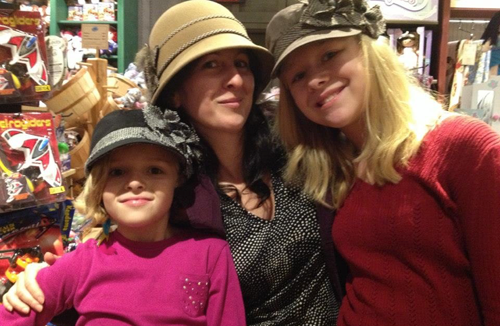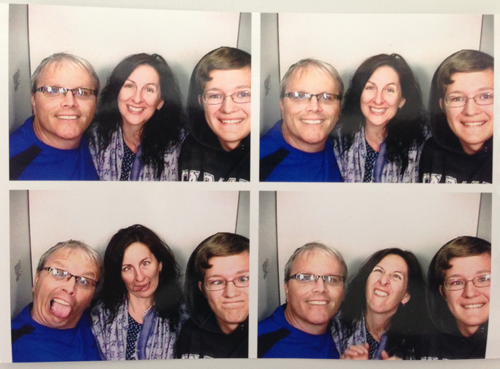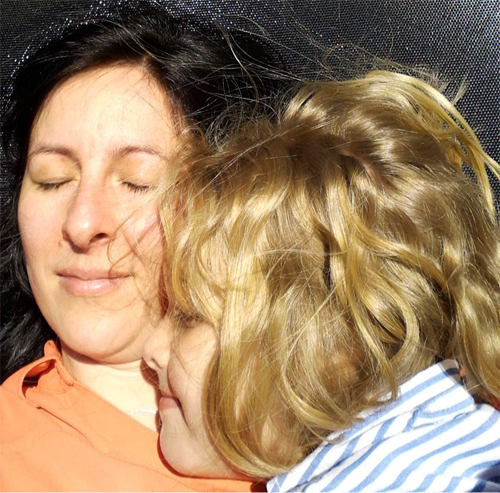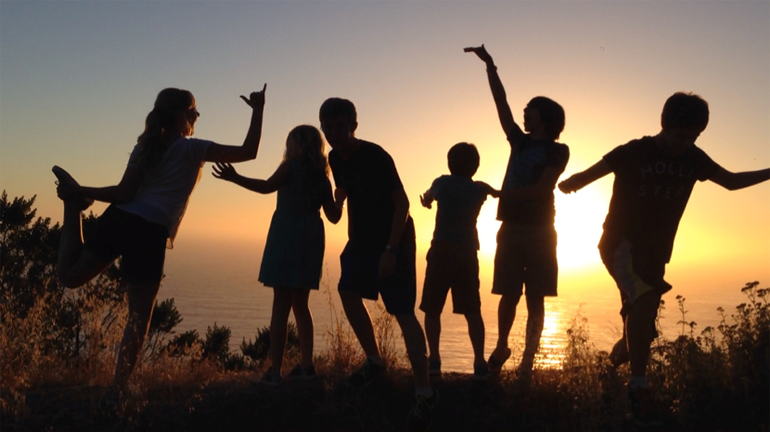“That girl said we have the same noses!” shouted my nine-year-old daughter. We were seated at a large, round table surrounded by goggling strangers squinting at us with wrinkled expressions. I felt their eyes on me, sizing up our noses.
Who was I? the strangers seemed to be wondering. Was I the mother?
It was late February and my children had just gotten off the slopes. The layers of clothing were slowly sliding off their sweaty, snowy bodies. I was seated in the rustic resort’s banquet hall for an awards ceremony for the kids’ ski club. While waiting for the presentation to begin, the conversation proceeded in a chit-chatty fashion between the other skiers and two of my seven children.
“Are you guys related?” asked one of the teenagers, peering through his long blond bangs at my daughter and me.
When meeting my children, new acquaintances will sometimes comment on the color of their hair: “Does your husband have blond hair?” I’m always surprised when the question comes up, and, when I reveal that my family is blended by adoption, I usually get some kind of approval for my kind deed. But, as affirming as it may seem, I would rather avoid “atta girl”-type praise from strangers.
Does it even matter? I ask myself. These children could be my stepchildren. Why are people so nosy?
But, depending on the circumstance, it can also be a great opening to talk about adoption and dispel some of the myths people have about adopting older children. I don’t want to reveal anything personal, but I also don’t want my kids to feel ashamed of or defined by adoption.
In the ski lodge, I thought about all the ways I could answer the young man’s question, and attempted to respond kindly and informatively—but my loud teenage son, the stand-up comedian, interrupted me. He sharply announced, “We look nothing alike.” I smiled, reflecting on my Greek and Polish ancestry. He continued to address my features—my almost-black hair and, specifically, my nose: “Her nose is a hook-like nose, looks nothing like mine, or hers,” as he pointed to his blond, blue-eyed biological sister.

The discussion fell silent. Our attention shifted to the window; the intensity of the snow was increasing, blanketing the empty summer furniture on the patio outside.
I sensed a few eyes wandering back to analyze my face, and then my son’s. Was I an impostor?
I started laughing as I looked at my son and shook my head, “It’s OK, I’ve heard this before, not the first time.” I smiled, nodded. Keep calm and carry on, I thought.
Do we need to look alike to belong to each other?
In truth, these comments reminded me of my teenage years. A few friends told me I didn’t look like either my mom or my dad (my third step father). The first time I heard the “hook nose” comment, in particular, was from my friend Brenda, in middle school. When I asked my mother, she told me it must have come from my paternal side. And I remember standing in front of the mirror, applying clear tape to temporarily “fix” my nose, so it perked up, instead of pointing down.
But most of all, as a child, what I wished was to be able to look in the mirror and claim my identity, to belong to my tribe. I was the product of an affair my mother had while she was married, and I learned very few details about my biological father when I was younger. I was told his name, which my mother remembered incorrectly. So the true story of my own conception was a mystery to both my legal father and biological father until I was an adult, when my mother finally revealed the truth to both of them.
The search for my “real” self led me to read many books about adoption. To my surprise, I strongly identified with the experiences of the adoptees. I, too, had an appetite to be reunited with my biological father and seek out cultural, ancestral, and medical information.
I suppose that story could have crippled me, but instead, I feel like I became more compassionate and understanding about these sorts of lost and found identity issues.
And, when I decided to become a parent, I felt that adoption was an ideal way to grow my family. We have a blended family—three biological children and four who came to us from Tennessee’s foster system via AdoptUSKids.
Because I treasure my biological identity, it’s important for me to respect my children’s, too. I think it’s important to discuss our physical features, like hair, body type, or noses. If we don’t acknowledge our inherited differences, we are asking our children to forget about a person who goes undefined. I know this all too well. The years of not knowing created secrets in my head during the teenage years.
And so, when our adoption was finalized we decided to re-establish contact with our children’s aunts, uncles, cousins, grandparents, mother, and father. A risky move, I knew, but it felt so right for us. The children’s caseworker in Tennessee was supportive and agreed to receive the letters and forward them in both directions. We wondered—would anyone write?
The letters came, then pictures, and then cards. A few phone calls, a Skype here and there, and then my husband established a private Facebook page. He shares school or sports photos and other highlights, and the kids go online and respond to the cheerful comments their birth relatives have posted. The messages are always inspiring and positive. We have experienced no jealousy, no drama, no blame, and no shame. Really.
My husband has maintained a level of respect and integrity throughout the life of the page thus far, and monitors it closely. These family members were present in our children’s early lives, when they were just babbling babies, toddlers, and elementary schoolers. I watch this reunion unfold and read the family stories they post. Their family’s stories have become ours and, together, we are all adopted.
Being the other mother, I let my husband take the lead while I back off and let the journey pace itself. It is not my place. I can’t imagine how this must feel for my children’s biological mother, to see her children with a new mom and dad. I cringe at the thought of the reverse. It takes strength to be happy for our happiness.

Though the kids’ family members could not take on the responsibility of raising these four amazing children, they are grateful to be reunited with them, to know that everyone is OK. And, in return, we are grateful for their contribution to our photo album. Pictures have brought the gift of closure, the primal desire I know so well myself—to know where we came from.
The photos we’ve collected include our children’s biological parents’ school photos. It’s in those little snapshots that I most closely see their resemblance—and I just swoon over that. I understand the importance of being lost and found in these photos. “You have her chin and her lips!” I tell my nine-year-old daughter. “And her blond hair,” she adds, complimenting her mother. “What beautiful hair she has.”
Many prospective adoptive parents are interested only in babies—fewer issues, more time to attach, they say. Our children were not clean slates, cuddly babies, or even curious toddlers. They have memories and feelings intertwined with chaos and love, just like any family has. They are insightful and perfectly flawed, and my husband and I feel grateful to have been chosen for them.
That night, at the ski lodge, I wore my nose as if it were a crown.
After the long evening at the awards banquet, and the drive home through the snow-covered landscape, I lay down beside my youngest daughter. Instead of a bedtime story we talked about how exhausted she was, and the joy in learning how to ski. I told her how beautiful she is, woven inside and out with love and strength. I hope she can uncover her true self, I thought to myself…it’s such a long path. We talked about her little nose and my hook nose. “That girl said we have the same nose, but I don’t think we do,” she said, then added, “But, when I grow up, I want to be just like you!”




